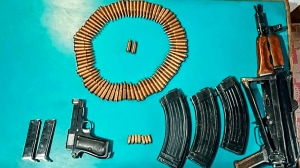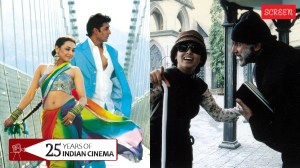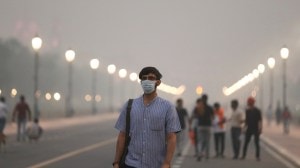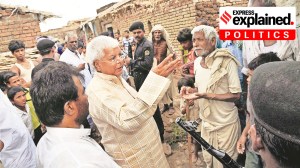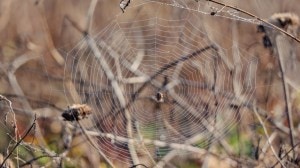That Sixties Show
A new biography of Arjan Singh sheds light on the 1962 and 1965 wars
The ICON
Jasjit Singh
KW Publishers,Rs 880
A new biography of Arjan Singh sheds light on the 1962 and 1965 wars
Military history makes fascinating reading,especially as told by the warriors themselves. There has been little of this in India and even anodyne official histories have come out years after the event on grounds of official secrecy,thus allowing the other side,if it so desired,to embroider the facts to its advantage.
The Icon not only tells the story of a great air warrior and gentleman,but also helps put the record straight in respect of certain matters pertaining to the 1962 and 65 wars. With his proud and daring record of service,Arjan Singh rose rapidly and was Air Officer Administration at AHQ from 1961 to 1963. The military had seen war coming after the Dalai Lamas flight to India in 1959 and the commencement in earnest of Chinese assertions to its territorial claims on
India. V.K. Krishna Menon,as defence minister,ruled out war thus fostering unpreparedness for the challenge to come even as Pakistan was rearming and modernising weapons with US assistance. Whatever little attention was given went to the army and there was no joint planning for the looming Himalayan war. Yet,the IAF played a notable role in logistical support and air supply in the most forbidding terrain. There was,however,no intelligence assessment and analysis of the possible use of air power on either side and the Defence Committee of the Cabinet had not met since 1959!
In 1962,the IAF was denied an air combat role in the belief that this would be escalatory and provoke Chinese retaliation by interdicting our air supply and bombing Calcutta and other eastern cities. The option of air interdiction of Chinese supply lines in Tibet was simply not considered. The field army had sought air support but the government looked away and,without reference to the IAF,approached the US for the loan of 12 F-104 fighter squadrons and two squadrons of B-57 bombers. The US responded by suggesting a joint US-India-UK-Australia air exercise,Shiksha,which showed up the essential shortages,including radars,that needed to be addressed. Arjan Singh was part of this effort and the subsequent (somewhat airy) decision in 63 to expand the IAF to a 64-squadron force.
Scenting military and political disarray in India after the 1962 debacle and Nehrus illness,Pakistani president Ayub Khan,driven by his foreign minister,the ambitious Zulfikar Ali Bhutto,planned a diversionary strike in the Rann of Kutch,using its newly acquired Starfighters and Patton tanks. The idea was probably to draw Indian troops south and then deliver the major blow it had planned in J&K through a guerrilla feint,Operation Gibraltar,a pretext to launch Operation Grand Slam to take Akhnur and move on Srinagar.
India cut its losses in the Rann,preferring to accede to arbitration,and trying to buy time to rebuild its forces. Arjan Singh had become air chief by now and recounts receiving a telephone call from his Pakistani counterpart,Asghar Khan,cleverly proposing both air forces refrain from flying over the disputed area of Kanjarkot (held by India) in order to prevent futile escalation. Arjan Singh reported this to defence minister Y.B. Chavan and the other chiefs.
The US refusal to admonish Pakistan for the misuse of its Starfighters and Pattons in Kutch and Indias accepting arbitration were read by Bhutto and Ayub as signaling that J&K was perhaps ripe for picking. They did not heed prime minister Lal Bahadur Shastris warning that if Pakistan persisted in aggression,India would choose the time and place for retaliation. On April 29,1965,the army chief got clearance from the PM for such a retaliatory strike in Punjab,but the air force and navy were,again,kept out of the loop. There was no joint planning. The army,from its World War II experience,assumed that the IAFs role was automatically to provide air support to the ground forces and little more.
Arjan Singh was consulted by Shastri. In response to queries put to him,the air chief replied that the IAF should be allowed to launch a full-scale attack that would surprise the enemy and inflict heavy damage on the Pakistan Air Force (PAF). He also sought permission to take out the PAF in East Bengal without fear of Chinese reprisals or damaging air attacks on Calcutta. Both options were put on hold with the result that the small PAF detachment in East Pakistan did considerable damage to our aircraft at Kalaikunda while the PAF found sanctuary in Peshawar and elsewhere in West Pakistan that were off limits and where aircraft reinforcements were ferried from Iran,Jordan,Saudi Arabia,all US allies operating aircraft similar to those in the PAF inventory.
Lack of joint planning was again sadly evident when the Indian Chhamb Brigade took the full weight of Pakistans Grand Slam offensive on September 1. The Brigade called for air support at 11 a.m. but the message was not passed on to the air force and was finally cleared by the defence minister at 4.45 p.m. The IAF was in action over Chhamb within 30 minutes and by last light flew as many as 26 sorties. Pakistans armoured column and massed infantry suffered considerable attrition and its offensive was blunted.
There were tensions within the army and at a high-level meeting,Lt.-Gen. M.S. Pathania,Sten gun in hand,rebuked the army chief,General J.N. Chaudhuri,causing Arjan Singh to walk up to him and tell him to cool down.
Pakistan later claimed it won the air war in 1965,a view the official Indian history partly endorses. Speaking through Arjan Singh,The Icon rebuts this with facts and figures to show that the IAF outperformed the PAF in vital parameters of air warfare.
There was some nervousness about Chinese reactions in support of Pakistan. They did indulge in some sabre-rattling at Nathu-La. Arjan Singhs personal diary records his reaction. He felt Chinas fighting capabilities were overrated in the context of 1962 when we just did not fight; we only withdrew in panic . This time we should be in a position to give them a good pounding from the air. We are better placed to do that than they are. PM is firm but some of his colleagues are nervous. The CAS was also sore about having his hands tied in East Pakistan and not being able to attack PAFs rear bases in West Pakistan. Ultimately,permission was granted and Peshawar and Kohat were bombed with good results. The PAF had no place to hide. It grew timid and was content to hit and run,as Arjan Singh privately noted.
What comes through in The Icon is the failure to recognise the full combat and interdiction role of the IAF and the failure of higher defence management. Imagine,the IAF air support was not sought on the first day of the armys Punjab offensive! Have the lessons been learnt? Yes and no. A beginning has been made with integrated defence planning but jointness is still debated. Arjan Singh was a dynamic warrior who truly earned his marshals baton. Let his minister,Chavan have the last word: When he is asked to go ahead on a new task,CAS even walks as a dancing bird. A real fighting Sikh. And yet how soft and gentle.



- 01
- 02
- 03
- 04
- 05









